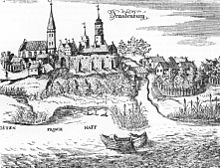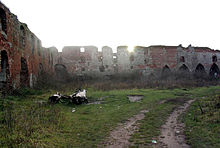Ushakowo (Kaliningrad, Gurjewsk, Novomoskowskoje)
| settlement
Uschakowo
Brandenburg (Haff) Ушаково
|
||||||||||||||||||||||||
|
||||||||||||||||||||||||
|
||||||||||||||||||||||||
The village of Uschakowo ( Russian Ушаково , German Brandenburg (Frisches Haff) , Lithuanian Pokarviai ) is located on the Frischen Haff in the Russian Oblast Kaliningrad in the former East Prussia . It belongs to the municipal self-government unit of the Gurjewsk district , identical in area to Gurjewsk Rajon . There it is located in the Novomoskowski rajon suburb . It is not to be confused with the village of the same name, which is also part of the Gurjewsk district, Uschakowo (the former Heiligenwalde), which is located in the outskirts of Nisowski rajon .
geography
Uschakowo is located on the river Prochladnaja (German: Frisching ), which flows into the Fresh Lagoon here . The Russian A 194 runs through the village , and until 1945 Reichsstrasse 1 from Aachen via Berlin to Königsberg (Prussia) .
history
For the Teutonic Order , Margrave Otto III. von Brandenburg built a castle at the Frisching estuary in 1266 to monitor the entry of ships into Königsberg . It was named after the founder and expanded in stone from 1275. From 1283 to 1499 it was the seat of a commander . Burned out in 1520, after the restoration it was the seat of an official governor from 1525 to 1752. After that, the stately palace was demolished after 1776.
A Lischke had developed under the protection of the castle, which received the hand-fest in 1513 . The church, built from 1320 to 1340, did not have a high, pointed tower until 1648. Brandenburg developed into a market town and had a small port since 1729. From 1818 Brandenburg belonged to the district of Heiligenbeil in the administrative district of Königsberg in the province of East Prussia .
After the occupation by the Red Army in 1945, the place fell to the Soviet Union and was renamed Ushakowo in 1947 after a buried Soviet soldier named Ushakow. At the same time, the place became the seat of a village soviet in Ladushkin district , which in 1965 in the village soviet Novomoskowski selski Sowet in Guryevsk district. From 2008 to 2013 Ushakowo belonged to the rural municipality Novomoskowskoje selskoje posselenije and since then to the urban district of Guryevsk.
Uschakowski selski Sowet 1947–1965
The village soviet Ushakowski selski sovet (ru. Ушаковский сельский Совет) was established in June 1947. The former German town of Pinnau was initially intended as the administrative seat. In July 1947, however, the former Brandenburg was set as the administrative seat. The village soviet was in Ladushkin Raion until 1962, in Bagrationovsk Raion from 1963 to 1964 or 1965, and in 1965 in Guryevsk Raion it was merged with the Zwetkowski selski Sowet to form the new village soviet Novomoskowski selski Sowet .
The following places belonged (initially) to the village soviet:
| Place name | Name until 1947/50 | Year of renaming |
|---|---|---|
| Gorki (Горки) | Tendons | 1947 |
| Ladygino (Ладыгино) | Korschenruh | 1950 |
| Ulyanovka (Ульяновка) | Klein Hoppenbruch | 1947 |
| Ushakowo (Ушаково) | Brandenburg | 1947 |
| Selenowo (Зеленово) | Pinnau | 1947 |
Population development
| year | Residents | Remarks |
|---|---|---|
| 1885 | 1,387 | Including the manor |
| 1910 | 1,385 | Including the manor |
| 1933 | 1,602 | |
| 1939 | 1,595 | |
| 2002 | 864 | |
| 2010 | 812 |
church
Parish
Before 1945, Brandenburg was the seat of an evangelical pastor's office. To it belonged a large parish within the church district Heiligenbeil (Mamonowo) of the church province East Prussia of the church of the Old Prussian Union . A total of 16 localities were incorporated into the parish (* = school location):
- Albehnen (Russian: Gorki)
- *Brandenburg
- Dümpelkrug
- Friedrichshof, district of Heiligenbeil
- Honey tree
- Klein Hoppenbruch (Uljanowka)
- Nod
- Korschenruh (Ladygino)
- Kranzberg
- Morken
- Pinnau
- * Pokarben
- Reginenhof
- Schoischen, 1938–1945 Schoschen
- Tengen
- Wedderau
Pastor until 1945
From the Reformation to the expulsion in 1945, the following ministered Protestant pastors in Brandenburg:
- Johann Ulrich, 1543
- Caspar Kurau, 1545
- Johann Schwartz, 1546–1573
- Andreas Kaufmann, 1569–1570
- Johann Gangolphus, 1570–1576
- Tobias Schweichel, from 1576
- Solomon Huebner, 1584
- Laurentius head nail, 1592–1600
- Georg Löselius, 1600–1609
- Petrus Nicolai, 1609-1617
- Heinrich Crusius, 1617-1620
- Johann Halbach von der Pforte, 1621–1639
- Georg Mylius, 1639-1640
- Daniel Nicolai, 1640-1661
- Valentin Schultz, 1661–1682
- Heinrich Pusch, 1682–1688
- Sigmund Frommhold Ring, from 1688
- Tobias Schweichel, 1693–1704
- Georg Hein, 1705-1740
- Johann Daniel Tapcken, 1739–1757
- Johann Christoph Wessel, 1758–1761
- Gottfried Sommer, 1761–1789
- Johann Gottlieb Meier, 1789–1830
- Franz Leopold Kopplius, 1852–1856
- Friedrich Otto Hoffmann, 1856–1882
- Carl Gustav Marter, 1882–1885
- Carl Heinrich AJ Dreschhoff, 1886–1897
- Gottfried Hermann Julius Podlech, 1898–1927
- Fritz Schiweck, 1927–1945
Attractions
The ruins of the Ordensburg and the tower of the parish church from the 14th century have been preserved. The ruin is included in Russia's state list of architectural monuments worth preserving. According to a list by Forbes Magazine , the castle is one of the most critically endangered monuments in the Russian Federation.
Brandenburg Castle was built by Margrave Otto III. Erected in the second half of the 13th century as a protection against the Pruzzen . In the time of the Teutonic Order it was an important commandery. From 1322 a fragment of the cross of Jesus is said to have been kept in the castle. The castle was destroyed several times in the 15th and 16th centuries. After the destruction in World War II , it has not yet been restored. Rather, it was used by Russian settlers for the extraction of building materials.
A relic of Catherine of Alexandria was brought to Brandenburg in 1378 from the collection of Emperor Charles IV as thanks for the support of Commander Günther von Hohenstein . The Warmia Bishop Heinrich III. Surbom took over the transfer after the death of the emperor. It was kept there in the castle chapel and later came to the Marienburg , where it was placed in the chapel of the Grand Master , the St. Catherine's Chapel .
literature
- Friedwald Moeller: Old Prussian Evangelical Pastors' Book from the Reformation to the Expulsion in 1945. Hamburg 1968.
Web links
- Brandenburg (Frisches Haff): Evangelical Church : Images in the color slide archive on Central European wall and ceiling paintings, stucco decorations and room furnishings of the Central Institute for Art History
- Description and idealized representation on an engraving from the digitized version of the Topographia Electorat {us} Brandenburgici et Ducatus Pomeraniæ. from around 1680, based on the copy from the Duchess Anna Amalia Library Weimar
- genealogy.net family research with backgrounds accessed on January 7, 2013
Individual evidence
- ↑ Itogi Vserossijskoj perepisi naselenija 2010 goda. Kaliningradskaya oblastʹ. (Results of the 2010 all-Russian census. Kaliningrad Oblast.) Volume 1 , Table 4 (Download from the website of the Kaliningrad Oblast Territorial Organ of the Federal Service for State Statistics of the Russian Federation)
- ^ Robert Albinus: Lexicon of the city of Königsberg Pr. And surroundings . Rautenberg, Leer 1985. ISBN 3-7921-0320-6 .
- ↑ Allegedly a hero of the Soviet Union, cf. Information on http://www.gako.name
- ↑ a b Through the Указ Президиума Верховного Совета РСФСР от 25 июля 1947 г. "Об административно-территориальном устройстве Калининградской области" (Decree of the Presidium of the Supreme Soviet of the RSFSR of July 25, 1947: Establishment of the Oblast-Kaliningrad)
- ↑ The Указ Президиума Верховного Совета РСФСР от 17 июня 1947 г. "Об образовании сельских советов, городов и рабочих поселков в Калининградской области" (Decree of the Presidium of the Supreme Soviet of the RSFSR of 17 June 1947: On the Formation of village Soviets, cities and workers' settlements in Kaliningrad Oblast)
- ↑ census data
- ↑ Hoffmann 1 (1810–1888) was a member of the Corps Masovia .
- ↑ The Ostpreußenblatt, 39/2010, 2 October 2010
- ^ Preussische Allgemeine Zeitung, 35/2010, September 4, 2010





